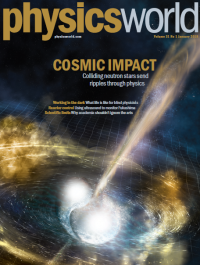Happy new year and welcome back to Physics World after our winter break. Why not get 2018 off to a great start with the January 2018 issue of Physics World, which is now out in print and digital format.
In our fantastic cover feature this month, Imre Bartos from Columbia University in New York examines the massive impact on physics that last year’s spectacular observation of colliding neutron stars will have.
Elsewhere, Bruce Drinkwater from the University of Bristol explains how he is using ultrasonics to monitor the damaged Fukushima nuclear-power plant in Japan, while science writer Jon Cartwright looks at how technology can help blind physicists.
Don’t miss either our interview with Fermilab boss Nigel Lockyer and do check out our tips for how to brush up your CV if you’re chasing a job in industry.
Remember that if you’re a member of the Institute of Physics, you can read the whole of Physics World magazine every month via our digital apps for iOS, Android and Web browsers.
For the record, here’s a run-down of what else is in the issue.
• Multimessenger work bags award – The Physics World 2017 Breakthrough of the Year goes to an international team that ushered in a new era of multimessenger astronomy, as Hamish Johnston reports
• Neutrino hunter – Nigel Lockyer, director of Fermilab in the US, talks to Michael Banks about the future of particle physics – and why neutrinos hold the key
• Why the arts matter – With many countries doing all they can to get more students into science and technology, can there ever be too much of a good thing? Paul Axelrod warns against ignoring other subjects
• The dark side – Robert P Crease describes his adventures creating a database to tackle the history of physics
• A new cosmic messenger – The first observation of gravitational waves from two merging neutron stars that was recently made by the LIGO and Virgo detectors has – along with date from telescopes across the globe and in space – kicked off a new era in multimessenger astronomy. Imre Bartos describes this watershed moment, which crowned decades of research and will shape the future of observational astronomy
• What next for Fukushima? – Nearly seven years after a powerful tsunami caused catastrophic damage to Japan’s Fukushima Daiichi nuclear-power plant, the clean-up and recovery is still ongoing. Bruce Drinkwater and Rob Malkin recently visited the disaster site and the undamaged Tsuruga plant to see if they can pinpoint the true extent of the damage in the dangerously radioactive reactors
• Physics in the dark – Modern technologies and educational policies aim to make physics fully accessible to the blind. But just how easy is it for the sightless, asks Jon Cartwright
• The man behind the machine –Vint Cerf reviews The Turing Guide by Jack Copeland, Jonathan Bowen, Mark Sprevak and Robin Wilson
• Let’s start at the very beginning – Sabine Hossenfelder reviews Origins: the Scientific Story of Creation by Jim Baggott
• How to write a good CV for industry – If you want a job in hi-tech industry, it pays to tailor your CV so that it makes the most of your business-relevant skills and expertise, says Andrew Hirst
• Once a physicist: Lydia Harriss – meet the head of physical sciences at the UK’s Parliamentary Office of Science and Technology
• How physics saved my life – physics teacher Russell Peters on his experience of the 2004 tsunami
Members of the Institute of Physics can read the whole of Physics World magazine every month via our digital apps for iOS, Android and Web browsers.

Guidelines
Show/hide formatting guidelines
this text was deletedwhere people live in harmony with nature and animals</q>
Some text